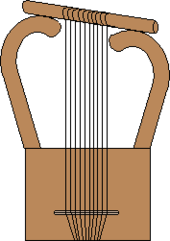Kinnor
Kinnor (Hebrew: כִּנּוֹר) is an ancient Israelite musical instrument in the yoke lutes family, the first one to be mentioned in the Old Testament.
The most important visual source for the kinnor is a relief from Niniveh, on display at the British Museum: As the Judahite inhabitants of Lakhish are sent into exile in 701 BCE, they are forced to play the kinnor.[1] | |
| Other names | harp of David, from Hebrew kinnor Dávid |
|---|---|
| Classification | String instrument |
| Related instruments | |
Its exact identification is unclear, but in the modern day it is generally translated as "harp" or "lyre",[2]:440 and associated with a type of lyre depicted in Israelite imagery, particularly the Bar Kochba coins.[2]:440 It has been referred to as the "national instrument" of the Jewish people,[3] and modern luthiers have created reproduction lyres of the "kinnor" based on this imagery.
The word has subsequently come to mean violin in Modern Hebrew.
Identification
The kinnor is generally agreed to be a stringed instrument, and thus the stringed instrument most commonly mentioned in the Old Testament.[2]:440 The kinnor is also the first string instrument to be mentioned in the Bible, appearing in Genesis 4:21.[4]
Details

Construction
Josephus describes the kinnor as having 10 strings, made from a sheep's small intestine,[2]:442 and played with a plectrum (pick),[2]:441 though the Book of Samuel notes that David played the kinnor "with his hand".[5] The International Standard Bible Encyclopedia also notes that the early church fathers agreed the kithara (kinnor) had its resonator in the lower parts of its body.[2]:442 Like the nevel, the kinnor likely consisted of a soundboard with two arms extending parallel to the body, with the arms crossed by a yoke from which the strings extend down to the body.[6]:43
One etymology of Kinneret, the Hebrew name of the Sea of Galilee, is that it derives from kinnor, on account of the shape of the lake resembling that of the instrument.[7] If this etymology is correct it may be relevant to the question of the shape of the instrument.
Usage
The kinnor is mentioned 42 times in the Old Testament, in relation to "divine worship... prophecy... secular festivals... and prostitution."[8] The kinnor is sometimes mentioned in conjunction with the nevel, which is also presumed to be a lyre but larger and louder than the kinnor.[6]:43 The Mishna states that the minimum number of kinnor to be played in the Temple is nine, with no maximum limit.[5]
Use of the word in Modern Hebrew
The word כינור kinór is used in Modern Hebrew to signify the modern Western violin.[9]
Image use in coinage
The image of an ancient lyre copied from what was proven to be a fake presented and sold as an ancient medallion, is in use on the 50 Agurot coin.
See also
References
- Staubli, Thomas, ed. (2007). Musik in biblischer Zeit und orientalisches Musikerbe (in German). Katholisches Bibelwerk, Stuttgart for Bibel+Orient Museum, Fribourg. p. 20. ISBN 9783932203671.
- Geoffrey W. Bromiley. The International Standard Bible Encyclopedia. Wm. B. Eerdmans Publishing. pp. 442–. ISBN 978-0-8028-3785-1. Retrieved 4 June 2013.
- Nathanael D. Putnam; Darrell E. Urban; Horace Monroe Lewis (1968). Three Dissertations on Ancient Instruments from Babylon to Bach. F. E. Olds. Retrieved 4 June 2013.
- Theodore W. Burgh (23 May 2006). Listening to the Artifacts: Music Culture in Ancient Palestine. Continuum International Publishing Group. pp. 20–. ISBN 978-0-567-02542-5. Retrieved 4 June 2013.
- Abraham Zebi Idelsohn (1929). Jewish Music: In Its Historical Development. Courier Dover Publications. pp. 8–. ISBN 978-0-486-27147-7. Retrieved 4 June 2013.
- Amnon Shiloah (1 May 1995). Jewish Musical Traditions. Wayne State University Press. pp. 137–. ISBN 978-0-8143-2235-2. Retrieved 4 June 2013.
- Jeremy Montagu, Musical Instruments of the Bible, Scarecrow Press, 2002, p. 15
- Jonathan L. Friedmann (8 January 2013). Music in Biblical Life: The Roles of Song in Ancient Israel. McFarland. pp. 71–. ISBN 978-0-7864-7409-7. Retrieved 4 June 2013.
- Jeremy Montagu, Musical Instruments of the Bible, Scarecrow Press, 2002, p. 12
External links
- Bo Lawergren, “Distinctions among Canaanite, Philistine, and Israelite Lyres, and Their Global Lyrical Contexts,” Bulletin of the American Schools of Oriental Research, No. 309 (Feb., 1998), pp. 41–68.

- "Kinnor". Encyclopædia Britannica (11th ed.). 1911.
- "Kinnor". New International Encyclopedia. 1905.